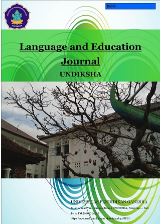APPLYING JANGOI FOLKLORE FROM PENYENGAT ISLAND ON ELT
Keywords:
Folklore, Jangoi, PenyengatAbstract
Teaching Eenglish as a foreign language in Indonesia had been a challenge. In the national curriculum, there is an idea to insert sociocultural aspect of Indonesia in the form of folklore into English language teaching (ELT). The researchers saw that Kepulauan Riau (Kepri) has many cultural entities, one of them is folklore. This study is to promote Jangoi, a coastal folklore story which has been uttered from generation to generation in Kepri, specifically in Penyengat Island, as a material to teach English. The research questions of this study are; how Jangoi become ELT materials, how were the students’ performances upon Jangoi, and how English teachers’ opinion about Jangoi. This study used R and D (research and development), that consists of four steps, that are 1) analysis and consideration upon student needs and context, (2) design and development the purposive work lesson; (3) implementation step, implementing Jangoi story in ELT, and (4) Evaluation. The result of this study are, Jangoi is needed to be processed before applied in ELT, by practicing the three steps, that are transliteration, Indonesia-English translation, and Translation-Validation. Students’performance upon Jangoi was good, it could be viewed from sets of multiple choice test and essay questions, and English teachers pointed that Jangoi can be applied in ELT.
References
Barfield, S. C., & Uzarski, J. (2009). Integrating Indigineous Cultures into English Language Teaching. English Teaching Forum, 2(1), 2–9.
Bean, M. S. (1999). The Role of Traditional Storied in Language Teaching and Learning. In M. R. MacDonald (Ed.), Traditional Storytelling Today: An International Sourcebook. Routledge.
Borg, W. R., & Gall, M. D. (2003). Educational Research: An Introduction (4th ed.). Longman Inc.
Brown, H. D. (2000). Principle of Language Learning and Teaching (4th ed.). Longman Inc.
Danandjaja, J. (1994). Folklore Indonesia: Ilmu Gosip, Dongen dan Lain-lain. Pustaka Utama Grafiti.
Dick, W., Carey, L., & Carey, J. O. (2001). The Systematic Design of Instruction (5th ed.). Addison Wesley Educational Publisher Inc.
Geeslin, K. L., & Long, A. Y. (2014). Sociolinguistics and Second Language Acquisition: Learning to Use Language in Context (First). Routledge.
Hyland, K. (2003). Second Language Writing. Cambridge University Press.
Kramsch, C., & Hua, Z. (2016). Language, Culture, and Language Teaching. In G. Hall (Ed.), Routledge Handbook of English Language Teaching (pp. 38–50). Routledge.
Malagina, A. (2019). Pulau Penyengat Pulau Kecil dengan Warisan Budaya Melayu yang Besar. National Geographic Indonesia. https://nationalgeographic.grid.id/read/131640656/pulau-penyengat-pulau-kecil-dengan-warisan-budaya-melayu-yang-besar?page=all
McGriff, S. J. (2000). Instructional Systems. Penn State University.
Melliti, M. (2013). Global content in global coursebooks: The way issues of inappropriacy, Inclusivity, And connectedness are treated in headway intermediate. SAGE Open, 3(4). https://doi.org/10.1177/2158244013507265
Shu, X. (2019). Sociolinguistics in Language Learning and Language Teaching. Open Access Library Journal, 6(E5650).
Sudartini, S. (2012). Inserting Local Culure in English Language Teaching to Promote Character Education. Jurnal Pendidikan Karakter, 2(1), 45–54.
Suseno, T. (2005). Pulau Paku. Basma Grafika.
Taylor, E. K. (2000). Using Folktales. Cambridge University Press.
Downloads
Published
How to Cite
Issue
Section
License
Copyright (c) 2023 Pradipta

This work is licensed under a Creative Commons Attribution-ShareAlike 4.0 International License.










